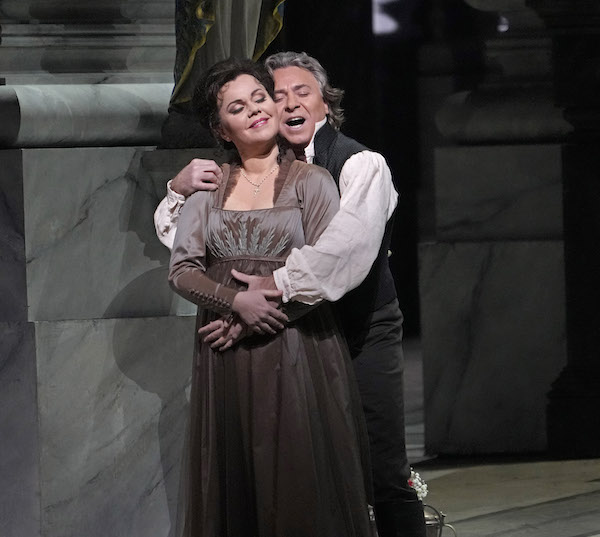Kurzak is a beguiling force in “Tosca”
Puccini’s Tosca returned to the Metropolitan Opera for the third time this season with a new cast save for Patrick Carfizzi’s Sacristan. Carfizzi is a keeper, but audiences don’t come to Tosca to hear a Sacristan, regardless of how entertaining he is. And with Aleksandra Kurzak singing the title role for the first time, they weren’t disappointed.
For those who like their Tosca stalking the stage, radiating passion and fury, Kurzak obliged. In Act I, she was befittingly coquettish and playful with her real-life husband, Roberto Alagna as Cavaradossi. In Act II, the predatory Scarpia describes Tosca as being too beautiful, and Kurzak certainly was that, as well as tempestuous, vulnerable and glamorous.
There were no histrionics, however, just the natural expression of fear and desperation that anyone would have when faced with Željko Lučić’s demonic Scarpia. In his jealous fixation with Tosca, Scarpia imagines her “supple as a leopard,” entwined with Cavaradossi. Only moments before, Kurzak and Alagna had sung while lying together in one another’s arms on a narrow settee — a feat few of their peers could execute so effortlessly.
Kurzak’s Tosca was sumptuously sung. With her essentially lyrical instrument, the Polish soprano is never going to please those who value vocal size above all else in the role. She does, however, have the requisite vocal allure, and with conductor Yannick Nézet-Séguin at his most attentive and accommodating, balance was never an issue. Her “Vissi d’arte” ticked all of the boxes.
It’s been over 25 years since Alagna’s Met debut, and while time hasn’t stood still, he still cuts a dashing figure on stage. For this performance, he sang with ardor and refinement, plus the vocal punch that has become his calling card. Alagna’s “Recondita armonia” was lyrical and rhapsodic, his “E lucevan le stelle” impassioned and glowing. The tenor isn’t only lithe, but nimble: He somersaulted across the stage after retrieving a bouquet of flowers tossed at Kurzak that went astray during the curtain calls.
Lučić is the blood-thirstiest Scarpia around. His penetrating stare and lascivious leer are terrifying. Lučić seemed to take special delight in terrorizing a new Tosca, especially one as dramatically acute as Kurzak’s tempestuous diva.
Lucia Lucas, in her Met debut, made an impression for her robust Angelotti (the American singer is a transgender baritone). Tenor Tony Stevenson as Spoletta took as much delight in sadism as did Scarpia. Bass-baritone Christopher Job cut a dashing figure, both physically and vocally, as Sciarrone.
There was just as much drama emanating from the pit as there was on stage. Nézet-Séguin drew thrilling sounds from the orchestra. The grumblings from the double bass and lower brass instruments were as menacing as Lučić’s Scarpia. Jessica Phillips, the Met’s acting principal clarinetist, played a particularly beautiful, mournful introduction to “E lucevan le stelle”. The Met chorus was superb.
David McVicar’s concept for Tosca is a movie set evocation of Rome in all of its splendor, save for everything being somewhat on an angle. The interiors of the Church of Sant’Andrea della Valle and the Palazzo Farnese are opulent and grand. Watching daybreak over the rooftop of Castel Sant’Angelo is not only beautiful, but moving. Much of the action of Act II takes place beneath a wall mural depicting what appears to be the Rape of the Sabine Women, their horror-stricken faces paying witness to Scarpia’s ruthlessness.
One can’t help but think that this run of Tosca is only going to get better, as Kurzak settles into the role. Singing Tosca for the first time at the Met isn’t for the faint of heart: Kurzak proved to be a lioness.
Tosca continues through March 12. metopera.org



